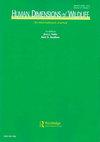使用心理测量学表征对黑熊宽容的认知前因
IF 1.7
4区 环境科学与生态学
Q2 BIODIVERSITY CONSERVATION
引用次数: 2
摘要
摘要对野生动物的宽容可以通过一个人的信仰、态度、规范或其他特征来决定。尽管理论论文强调了野生动物耐受性的这些多重前因之间的相互关系,但实证研究并没有使用严格的规模发展过程来测试它们。我们使用心理测量学来表征对黑熊(美洲熊)宽容的认知前因。通过网络问卷(n=240)测试了拟议的量表项目,并将其细化为29个项目,代表了对黑熊容忍度的五个先行维度。然后,我们对俄勒冈州西部的不同娱乐步道使用者样本(n=210)进行了这些项目的管理。二阶验证性因素分析证实了一项19项指标,该指标代表了容忍度的四个不同但相关的先行维度:反感、联系、致命控制(损害)和致命控制(对自我的危险、宠物和经济)。这些维度有助于更好地解释为什么人们对黑熊以及其他野生动物或多或少都有容忍度。本文章由计算机程序翻译,如有差异,请以英文原文为准。
Using psychometrics to characterize the cognitive antecedents of tolerance for black bears
ABSTRACT Tolerance for wildlife can be informed by a person’s beliefs, attitudes, norms, or other characteristics. Although theoretical papers emphasize the interrelations of these multiple antecedents of wildlife tolerance, empirical studies have not tested them using a rigorous scale development process. We used psychometrics to characterize the cognitive antecedents of tolerance toward black bears (Ursus americanus). Proposed scale items were tested via web-hosted questionnaire (n = 240) and refined into 29 items representing five antecedent dimensions of tolerance for black bears. We then administered these items to a different sample of recreational trail users in western Oregon (n = 210). Second-order confirmatory factor analysis confirmed a 19-item measure representing four distinct yet related antecedent dimensions of tolerance: antipathy, connection, lethal control (damage), and lethal control (danger to self, pets, and economics). These dimensions help better explain why people may be more or less tolerant toward black bears and, potentially, other wildlife.
求助全文
通过发布文献求助,成功后即可免费获取论文全文。
去求助
来源期刊

Human Dimensions of Wildlife
Environmental Science-Nature and Landscape Conservation
CiteScore
4.40
自引率
12.50%
发文量
33
期刊介绍:
Human Dimensions of Wildlife is devoted to the study of social considerations in fisheries and wildlife management.
 求助内容:
求助内容: 应助结果提醒方式:
应助结果提醒方式:


